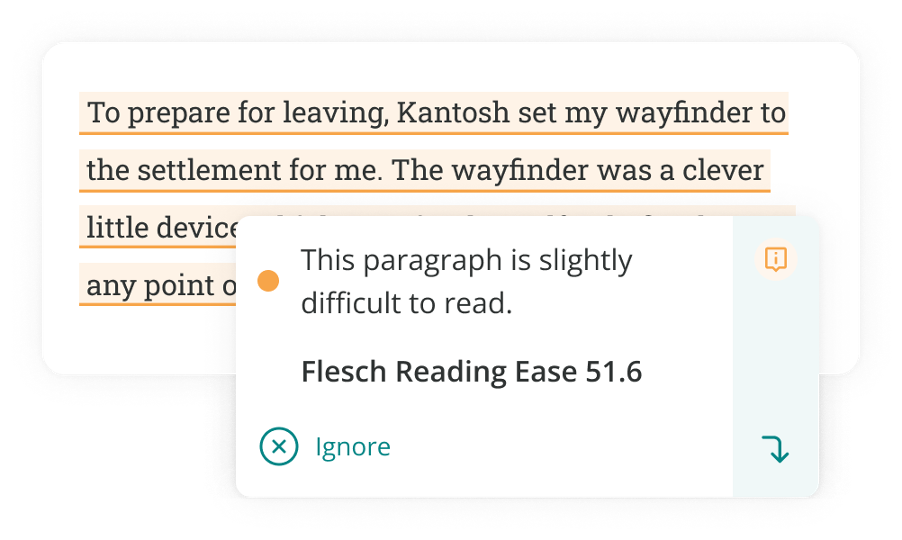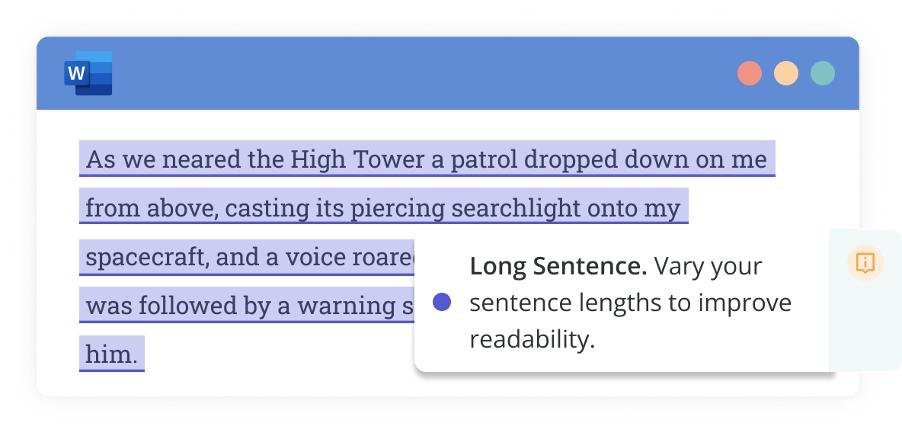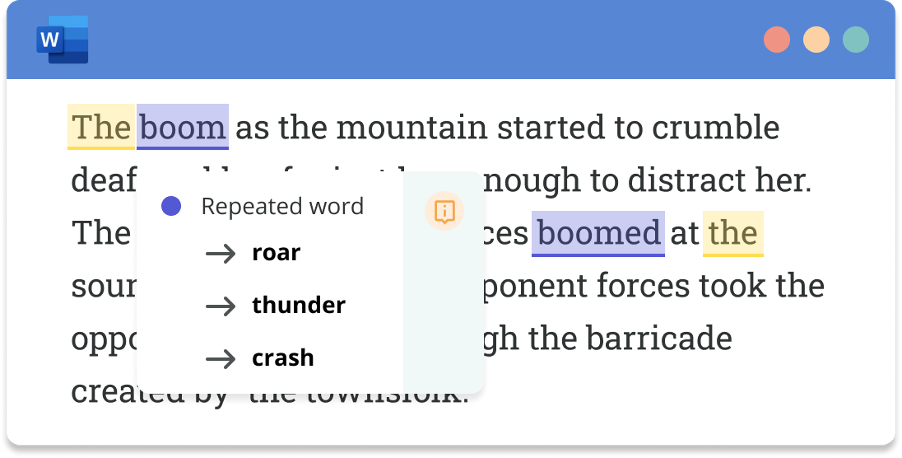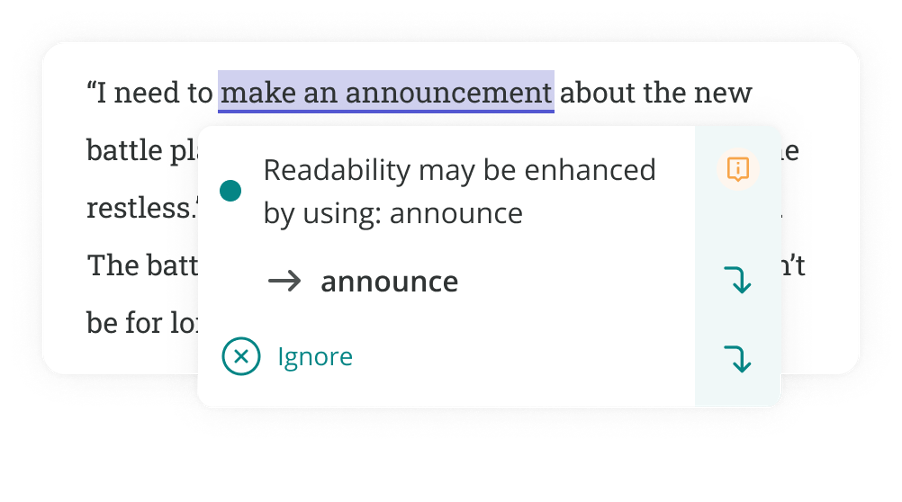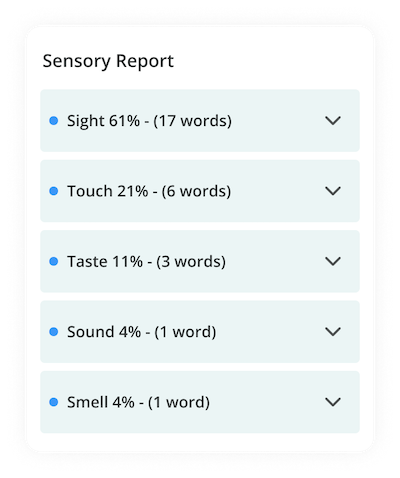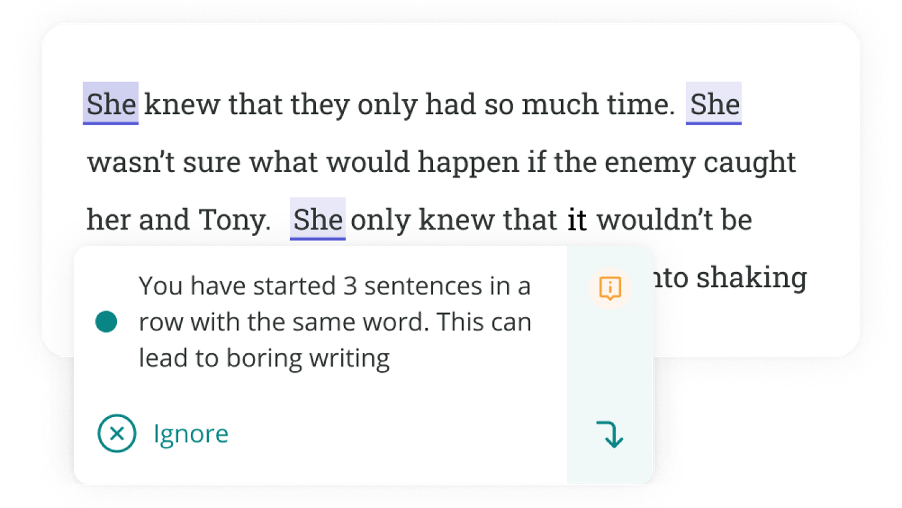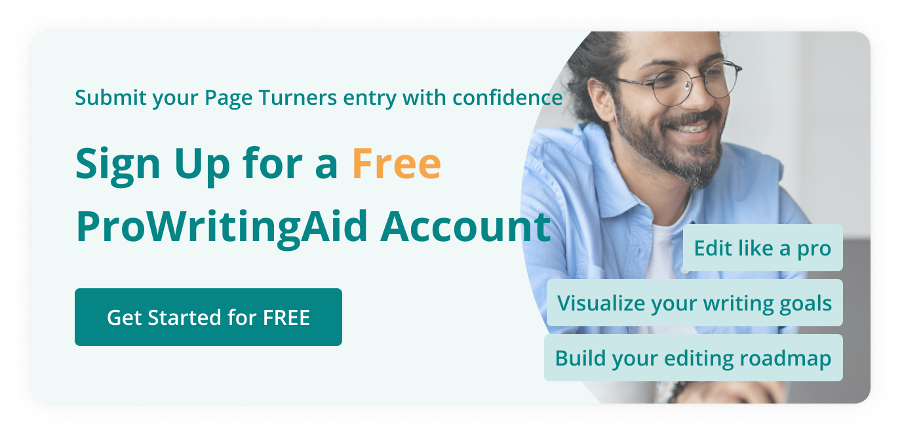10 Key Things to Look For in a Copy Edit
We’ve found that writers either love or hate editing. Some thrive in diving into the details and working out how to craft the perfect sentence. Others find the whole process overwhelming.
Like writing, editing is a skill. But fortunately, it’s a skill that can be learned—and there is help out there!
ProWritingAid is a grammar checker and self-editing software that helps to take the guesswork out of your editing process. With 25 reports focussed on the key improvements real editors make, ProWritingAid streamlines your process by showing you where to start (and where to go from there).
If you want to learn as you edit, track your progress in real-time, and make sure that your words are doing your story justice, give ProWritingAid a try for free.
If you’re entering the Page Turner awards, these steps will help you polish your 3,000-word chapter (or equivalent first ten pages of your manuscript) before submitting it to the competition. And if you’re just looking for some great copy editing advice? Keep reading for our list of the 10 things to look out for in your edit.
When Should I Copy Edit?
The first thing you need to decide is whether your manuscript is ready for copy editing.
If you were building a house, there would be no point trying to fit windows before you’d built the main structure. Sure, the windows are necessary. But if there are no frames to put them in, you’re going to end up with a whole lot of broken glass.
Copy editing should come after your developmental edit. That means you need to have your story structure in place before you start zooming in on the details. Once you know that your key plot points are in order, your point of view is consistent, and your character arcs are satisfying, you can move on to your copy edit.
1. Prioritize Your Readers by Checking Readability
One of the hardest parts of copy editing is knowing where to start. Checking your readability can give you some useful clues.
What is readability? As the name suggests, it’s a measure of how clear your writing is. Readability measures how easy it is for your readers to understand and engage with your ideas.
Most fiction readers like to read at 7th-grade level. That doesn’t mean they are reading books for 7th graders. Instead, the best authors are able to tell complex stories through simple language to make them accessible and enjoyable for readers.
Some of the factors that affect readability are:
• Poor sentence length variety
• Overly-complex vocabulary
• Over-using the passive voice
• Using vague language
When deciding where to focus first, look for sections of your text that include these factors. If you’ve written a paragraph that is two 50-word sentences in a row, your reader may start to struggle. We’ll cover how to fix each of these writing mistakes next.
Spotting areas where your writing is difficult to read is difficult on your own. You know what you meant, after all. ProWritingAid’s Readability Report highlights difficult, slightly difficult, and easy to read paragraphs in your text so you know where to focus first.
It also gives you an overall and paragraph-by-paragraph readability score based on systems used by writing experts. All scores are based on averages for your genre, you know you’re heading in the right direction.
So, how can you improve your readability?
2. Keep Readers Engaged by Varying Sentence Lengths
Imagine you’re hacking your way through a jungle. You come across a bush, and manage to cut through it relatively easily. Then you meet another four bushes, and then another five—if you keep having to muscle your way along the path, you’re going to get exhausted fast.
Think of your sentences in the same way. Your reader can handle long sentences, but if you keep using them, eventually they will get tired of fighting their way through to your meaning.
Varying your sentences gives your reader a chance to process what you’re telling them and to link one info-heavy sentence to another. It also stops sentences from blurring into one.
On the other hand, too many short sentences will feel disjointed, and prevent you from setting up more complex ideas that tell your reader more about your characters. Balance is key.
As you read through your chapter, notice where you’ve used several similar sentence lengths in a row. If you find too many long sentences, look for areas where you have introduced several new ideas in one sentence, and split them to make them easier to read. If you’ve unintentionally grouped your short sentences, check whether you’re giving readers enough detail.
When checking for variety, it helps to visualize your sentence lengths. The Sentence Length Report in ProWritingAid shows you all of your sentences as bars on a chart so you can easily spot where you need to add some variety. It’ll also highlight especially long sentences in your text so you can rethink them if needs be.
3. Add Excitement with Expert Pacing
Varied sentence lengths are a useful tool to help balance your pacing—but it comes down to the ideas you’re sharing, too. Even if you aren’t writing an action or fantasy story, you still need to balance backstory and exposition with action and dialogue.
There is no set rule, but if your narrative spends more than a few paragraphs in your protagonist’s head without them doing anything or speaking to anyone, readers might start skipping sections looking for action.
Highlight sections of your text where you step back and explain what’s happening to your reader. Do you spend paragraphs re-telling a pivotal argument your protagonist had with their parents? Or explaining the lore of the two opposing forces in your battle scene?
Yes, your reader needs to understand what’s happening. But often they don’t need all the details. They need to see how those details manifest themselves in the present-day of your story.
Ask yourself:
• Does my reader need to know this to understand the stakes of my story?
• Can I reveal that detail through dialogue, subtext, or body language?
• Do I need to explain this all in one go, or will it become evident as my story progresses?
On the flip side, if your story is all action and dialogue, you’re probably not giving readers enough detail to care about your characters. If your protagonist feels excruciating pain when another character dies, you need to have set up the relationship to explain why.
Before you start editing for the finer details like word choice, take a wider overview and make sure your story’s pace feels satisfying. If you’re not sure where to start, ProWritingAid’s Pacing Report highlights slow paragraphs so you can check that you haven’t used too many in a row.
4. Unstick Your Sentences to Use Your Words Effectively
We’ve taken a look at the bigger picture: readability, sentence lengths, and pacing. Now we’ll start to zoom in.
Sticky sentences contain a high percentage of glue words. These are the 200 most common words in the English language, like the, was, on, so, and, of, with, etc.
Without glue words, your sentences would fall apart. However, they don’t add anything to your meaning—they just help to stick the meaningful words together. The idea is to use this glue strategically, so your readers don’t notice it’s there.
Take this sentence:
After I got home from work late in the evening yet again, I went to the kitchen, opened the refrigerator, and poured myself a very large glass of wine.
Glue Word Percentage: 56%
In this sentence, the reader has to fight through half a sentence full of glue words to get to the meaning.
When you notice a sentence with a high percentage of glue words, consider what you are trying to tell your reader.
In this example, we’re trying to say that the character is frustrated and exhausted from a series of long working days. Let’s try re-writing:
I kicked off my work boots, poured an inadvisably large glass of wine, and collapsed on the sofa in my dark apartment.
Glue Word Percentage: 36%
Both sentences tell us the same thing, but the second one gives us more of a sense of how the character feels. The reader can probably guess that the wine came from the kitchen, and they don’t really need to know if it was chilled or not. Instead, we use our words more effectively by honing in on those emotions: frustration and exhaustion.
Spotting glue words like this takes time. ProWritingAid’s Sticky Sentence report highlights sentences with a glue index of over 40% so you can focus your attention where your edits will make the most impact.
5. Banish Passive Voice for Stronger Sentences
You want to show the judges that you are in control of your story. Writing as decisively as possible (unless you are purposefully trying to convey indecision) helps you do this.
Passive writing puts the subject of your sentence second.
In passive sentences, the action in the sentence (the verb) happens to the subject, rather than the subject driving the action.
Here’s an example:
The door was opened by his wife.
Let’s convert that to active:
His wife opened the door.
Not only is the second sentence shorter, it also gives us the most important information up front. We’ll put the sentence into context to see how this works:
There was a knock on the hotel room door. Room service? He hadn’t ordered anything. The woman in the bed next to him barely stirred.
"Come in," he called.
His wife opened the door.
Using the passive voice would decrease the tension in the scene. It would also sound clunkier. Switching to active voice allows us to realize the stakes in the scene, and connect information more effectively.
ProWritingAid highlights instances of passive voice and offers potential active rephrasings so you can fix it with a click.
6. Reduce Repeats to Keep Things Fresh
You only have 3,000 words to absorb the judges in your story, so you’d better make each one count.
Have you ever noticed when an author favors a particular word in their descriptions? Maybe every character has a "wry smile" or every loud noise is a "crash."
At best, repeated and overused words become white noise that your reader has to filter through. At worst, they’re distracting or even annoying.
As you edit, look for the words you rely on in your descriptions. If you use the word "powerful" several times in your chapter, the power you’re trying to convey gets diminished.
Once you’ve taken a bird’s-eye-view of your chapter, make sure to double-check your paragraphs too. Using the same word repeatedly in a paragraph can lead your reader to re-read the previous sentence to see whether you’ve written the same sentence twice.
Repeats, especially close repeats, pull your reader out of your story and make them focus on the mechanics of your writing.
While the judges will be looking at this, your aim is to immerse them in the story so effectively as to almost make them forget the writing on the page.
7. Avoid Overused Words
Aren’t we—ironically—repeating ourselves here?
Overused words are different to repeated words, though they are often repeated once you start using them.
These are words that many writers overuse, like really, very, would, felt, and saw. All of these indicate that you’re using weaker adjectives or verbs where a strong adjective or verb would be more effective.
Identifying overused words helps you find areas where you can be more specific. These are all opportunities to layer your personal writing style into your work by creating descriptions that convey your meaning effectively.
So, instead of saying someone is really tall, say they towered over your character. When you use vague words like "would" or "could," make sure you’re using them to purposefully convey indecisiveness. Using them too often in your POV narrative makes your voice sound unconvincing.
8. Reveal Your Verbs to Strengthen Your Writing
Hidden verbs weaken your writing. They separate the actor from their action, and make your writing sound indecisive.
So what is a hidden verb?
Here are some examples:
• Make an announcement → announce
• Reach a conclusion → conclude
• Make a decision → decide
• Make stronger → strengthen
• Take into consideration → consider
• Give information → inform
In the first examples, you give all the power to a weak verb like make, give, reach, or take, sidelining the verb you actually want to use (e.g. decide, consider, announce).
Verbs drive your story forward. They inform, inspire, and engage. But when you hide them, they become detached from your story and characters.
To find and fix hidden verbs, look for the weak verbs that come before them like reach, take, make, and give.
Verbs are powerful tools for writers—show that you have full command of your writing toolkit by setting your verbs free.
ProWritingAid highlights hidden verbs so you can swap them for stronger alternatives.
9. Unleash Your Senses for Richer Description
We all experience the world in different ways. And yet many writers rely almost exclusively on visual words to describe their worlds and characters.
This can make your writing feel stale. So how do we fix it?
Highlight all of the sense words in your document. That’s any word that relates to touch, smell, taste, sound, or sight. Note which sense you tend towards, then assess where different senses may produce a more effective description based on your character and story stakes.
For example, if a character is afraid of the dark and you’ve thrown him into a dark room, instead of focusing on the lack of light, use sound or touch words to heighten his fear of the unknown.
ProWritingAid’s Sensory Report highlights these words for you, saving you time on spotting them yourself.
10. Check Your Grammar, Spelling, and Style
Nothing makes readers lose confidence faster than a typo. So why didn’t we put this step first?
Diving right into your grammar, spelling, and style edits before you’ve fixed sentence length, word choice, and other structural issues can lead to wasted time. Either you’ll fix things that you cut out later, or you’ll miss mistakes in sections you add.
However, once you have everything else in place, it is vital to make sure your writing is as polished as possible.
During this stage of your edit, you’ll look for:
• Spelling mistakes
• Misused punctuation (think comma placement, spacing, ellipsis consistency, misused colons/semi-colons, etc.)
• Grammar errors (such as subject-verb disagreements, incorrect article use, wrong tense usage, etc.)
• Repeated sentence starts
• Unnecessary words
• Overuse of adverbs
• Redundant words
… and more!
Making simple grammar and spelling errors can suggest you don’t care about your entry. Submitting error-free work gives you the best chance of persuading the judges to read (and love) your chapter in its entirety.
ProWritingAid’s Realtime Report highlights thousands of errors that real copy editors would spot. It remembers all those grammar rules and writing style tips so you don’t have to, helping you focus on making your writing as clear and entertaining as possible.
Do I Have to Follow the Rules?
Remember, your work is your own, and the judges want to hear your voice. The changes you make are entirely up to you. If you think passive voice or a hidden verb adds to the effect of a certain sentence, leave it in!
There’s no such thing as perfect writing, but by following these tips, you can submit your entry to the Page Turners with confidence.
Good luck!
You Have the Ideas, ProWritingAid Helps You Share Them
Save time and streamline your editing process by editing with ProWritingAid.
Sign up for a free account to:
• Improve as you edit with in-built learning resources
• Get personalized feedback and goals so you know where you focus
• Track your progress with genre-specific writing goals


